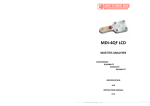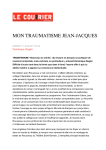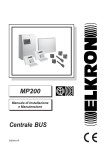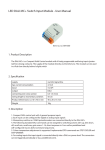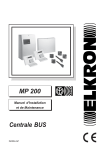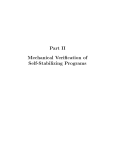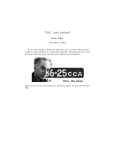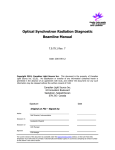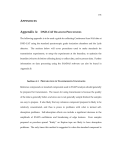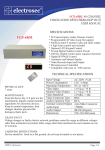Download LOADING THE MASK AND THE SAMPLE
Transcript
X-ray Interference Lithography User Guide 1 October 2006 STARTING THE COMPUTER APPLICATIONS Log on to the computer (PC4027). Ask beamline staff for Username and Password. X_XIL launcher starts automatically when you logon to the computer Using the X_XIL launcher start the programs you need, for example: XIL Standard GUI’s SIS launcher Tools -> Strip Chart (e.g. for plotting Keithley 6514) Move the SIS launcher to a different (second) quadrant of the screen On the SIS launcher start Beamline Synoptic Panel Machine Info Panel Undulator -> Main ID1 Undulator -> Main ID2 To reboot: (1) Logout (2) In the login window go to system → reboot BEAMLINE CHECKS AND SETTINGS When you come in, change the status on the “Beamline and Experiment Status” panel to “attended”. Before you leave change it to “unattended” or “offline” Check the status of the beamline valves on the SIS panel. The EPS system opens the valves of the branch (SIS or XIL) depending on the XIL mirror position. If the mirror is out and the valves are open then you need to (1) close the valves (2) close cooling before you can move the mirror in. Check that the XIL switching mirror is IN. If not move it IN. Check the ID status on “main ID1” and “main ID2”. Check the beamline logbook for recent settings. At the time of the update of this maual typical settings were ID1=92.1eV, ID2=92.3. Use linear horizontal polarization by clicking on the button LINEAR-H. Check that the magnet current readings on those (mainID1 and mainID2) windows are not zero Check that the current monochromator grating is G1 300 (300l/mm) on the SIS Synoptic Panel. If not ask for help from SIS people. Open the “SIS main control” from the SIS Synoptic panel by clicking on More in the monochromator area. Using this panel set the monochromator to 0th order light by setting the angles of PM1 and PG1 to input beta=-82.8000, theta=82.80000. CAUTION: there is a possibility of crashing the grating and mirror into each other. In order to move in the safest possible way change the angles in the following order: Check the current values for “input beta” and “input theta” Move either the grating or the mirror is such a way that the angle between the two elements decreases e.g. if the original angles are β=-83.5o and θ=87.6o then the angle between the two elements Δ=4.1o. In this case you should first start moving θ by entering 82.8. Once θ starts moving you can enter -82.8 for β and let them move together. In that way you avoid further increasing the angle between the elements. Write the CMU settings and the FE center values that were in use by the SIS users in the XIL logbook. Then change the CMU settings to the ones that were last recorded in the XIL notebook. Hint: Most recent settings of most parameters can also be found in the latest exposure files, e.g. oxil030917a.dat 1 LOADING THE MASK AND THE SAMPLE For venting the chamber see the section on removing the sample. Mask mounting: Move the sample stage to the sample exchange position (25mm on both axes). Grab the mask disc on the edge, being careful not to touch the membrane area. Use a tight fitting glove. Orient the disc as close as possible to its final orientation before bringing it close enough to the holder for the magnets to pull in. Experiment with a dummy disc before doing this with a real mask. Once it is grabbed by the magnets check if it is properly placed. Push the disc towards the bottom and side pins with your thumb while supporting the tube with your other fingers. Be careful not to apply any lateral force to the tube. Once it is in position check that the mask is still intact! Sample mounting: Mount your sample on the sample holder plate (SHP). Carefully place SHP on the three pegs (long pins). Turn the three spring loaded nuts to secure the SHP in place. CAUTION: Make sure that the mask is at a safe distance from the sample. Be especially careful if you are using the chip holder or other “thick” samples. PUMP DOWN Close the chamber door Make sure that enough time has passed for the turbo to vent itself (~2min) if it has just been turned off. Check that the manual chamber vent valve is closed. Turn the pumps on: If you are in the cleanroom press the green button above the turbo pump. If you are outside then use the “EPS Exposure Chamber” panel to start pumping by clicking on the START Turbo pump button (You may need to push the STOP button first if the turbo was not stopped on that panel last time). After starting the pump check the chamber door to see if it has been pulled shut by vacuum. If not gently push on the door. Make sure that the plastic bag is not caught in the door. The shorter you keep the chamber open the shorter the pump down time will be. Try to keep the chamber door closed as much as possible while the chamber is vented. Keep N2 flowing at a reasonable rate. MOVE THE SAMPLE STAGE TO THE STARTING POSITION and THE 3rd DIODE TO DIODE POSITION! If you are not in a hurry to expose your sample let the turbo, pump the chamber alone for as long as possible. Otherwise open the gate valve to the ion pump (VG1) once the pressure is below 6e-6 mbar. Turn the turbo off once the pressure is below ~2e-6 mbar. Watch the pressure on the pressure strip chart. Remember that the turbo blades will continue to turn for up to 2 min after it has been turned off. Assuming that the sample has been loaded and the exposure chamber pumped down to low enough pressure (“OK” should appear above the MP1 pressure on the XIL panel) you can proceed with the exposure. PREPARING THE EXPOSURE FILES To go to the linux directory where the exposure files are stored: cd /sls/X09LA/data/X09LA/XIL/tmp You can prepare your file using Excel and save it as a text file when the file is ready. Transfer the file to the Linux system via the ftp site of PSI. e.g. you can use ftp://ftp.psi.ch/PSI_intranet/xil/ An easy way to create your exposure data file is to choose an old file that has data similar to what you need to a new file and modify it. e.g. cp ixil030718a.dat ixil030821b.dat CAUTION: When you prepare the data file, try to minimize the stage motion in order to minimize the risk of heating related vacuum and drift problems. To start an editor: nedit filenmane.dat or vi filename.dat 2 SETTINGS FOR EXPOSURE Check that the cooling is on, (SIS panel). If not turn it on. Open the beamline valves (SIS panel). Open the last valve before the endstation (VG4) on the XIL panel. The beam shutter on the SIS panel has to be closed for VG4 to operate. If the pressure in the exposure chamber is good enough to open VG4 “OK” will appear above the MP1 pressure on the XIL panel. If not wait until the set pressure point is reached. Move the sample stage to the position of your first field. Move the second diode to "phosphor" position. Move the third diode to "diode" position Hint: It is better to do the motor movements in the last two steps immediately after you start to pump down the chamber in order to avoid unnecessarily heating the motors just before the exposure. Open the beam shutter on the SIS panel Open the FE slits to 2x2 mm on the SIS panel Check the beam on the second phosphor using the monitor. If necessary, switch the monitor input to the camera on that phosphor screen. If there is no beam, the beam may be completely off the pinhole Tweak the pinhole position using a 1 or 2μm step size to optimize the beam image on the phosphor if necessary. (Open the pinhole motors …) Move the 2nd diode to OUT position. Check that the 3rd Diode is IN Click on EXPOSURE SW on the XIL panel. An exposure panel will pop up. Enter the K value (3.71e3), settling time 2-3sec, and aperture area in cm2. Then press "flux" to calculate the current power density in mW/cm2 Enter the exposure input and output file names. Type in comments e.g. sample, mask and gap Enter the desired settling time for the stage (e.g. 2 sec). Enter the “VAC THRESHOLD” value 5.0E-6, if it is not already set to this value. If you want the program to close the main beam shutter after the exposure is finished press the button Close Shutter next to the words “After Experiment” on the panel. This is especially useful if you are not going to be around when the exposure finishes, to close the shutter yourself. Prepare the Keithley 6514 Diode strip chart for current observation. Open the exposure shutter on the XIL panel Check the current on the Keithley 6514 using the strip chart. Adjust the range of the graph if necessary (use buttons below the chart. Tweak the pinhole position to maximize flux. Press CALCULATE FLUX to record the flux measurement Make the flux measurement and CLOSE the exposure shutter on the XIL panel as quickly as possible after the flux measurement. This is necessary to prolong the life of the photodiode which is quickly damaged by the high flux of the beam. Remove the third diode to "out" position 3 EXPOSURE Press "Load" on exposure panel. A graph showing exposure time versus field number will pop up. Use this as a sanity check for your exposure times Press "start" on exposure panel. On the lower right corner of the exposure panel you can see how many fields are left to go Use a strip chart to watch the “exposure pulses” as a confirmation of the photonic activity in the chamber! Once the exposure is finished close the "shutter" on the SIS panel. Close the endstation valve VG4. Close the ion pump valve VG1 on the EPS EXPOSURE CHAMBER panel At any point during the exposure you can interrupt the exposure by pressing STOP and resume by pressing CONTINUE. You can abort the current exposure by pressing ABORT. Output file will contain information including the data for the last exposed field. In order to run the exposure program again you need to press CLEAR on the panel. VENTING THE CHAMBER AND REMOVING YOUR SAMPLE Move the stage to the sample exchange position: x=25 y=25 Move the mask to a safe distance from the sample. Turn off the turbo pump - if it is on - by pressing the red stop button in the cleanroom or by pressing the STOP Turbo Pump button on the EPS Exposure Chamber panel. Open the N2 bottle valves. Adjust the regulator to ~1bar. Three valves on the endstation have to be closed in order for the computer controlled vent valve to open: VG1 (between chamber and the ion pump) VG4 (between chamber and beamline) Gate valve above turbo If all three valves are closed you can vent the chamber by clicking on VG:vent OPEN on the EPS Exposure Chamber panel. Once the computer controlled vent valve is open, SLOWLY open the manual vent valve to vent the chamber CAUTION: venting the chamber too fast can break membrane masks! Leave a low N2 flow to keep the chamber dry. Don’t forget to close the manual valve before you start the turbo pump 4 BEFORE YOU LEAVE Return SIS CMU positions to the original values used by SIS branch users. Close beam shutter on SIS panel Close VG4 on XIL panel Close beamline valves on SIS panel Turn cooling off on the SIS Synoptic panel Move the XIL switching mirror to the OUT position Close both valves on the N2 bottle Change the status on the “Beamline and Experiment Status” panel to “unattended” or “offline” If you are leaving for a long time turn the undulator ID1 and ID2 currents off (drive all zero) If the next users are going to be on the SIS endstation change SIS grating to Cff=2.25 by pressing set energy on the “SIS Main Control” panel. Leave the chamber in pumped down state with the turbo on and the gate valve to the ion pump closed KEITHLEY SETUP Start the Keithley’s from the X_XIL launcher: Tools -> KEITHLEY EXP 6514 Tools -> KEITHLEY OPTICS 6485 Run -> Poll Choose settings: NPLC=3, Averaging=3 Channel name for stripchart: X09LA-OPA-K6514-read X09LA-OPA-K6485-read CAUTION: Always quit the Keithley programs from the pull-down menu Run -> Exit. Never simply close the window! SWITHCING BETWEEN MONOCHROMATOR GRATING On the SIS-PGM panel (SIS main control) press the ! button Launcher – Monochromator – Restore settings – grating calibration Choose a file – view with INFO Restore with RESTORE Name Harun Solak Vaida Auzelyte Markus Kropf Luc Patthey Ming Shi Jurai Krempasky SLS Control room PSI 056 310 4279 5807 5961 4562 2393 8434 5500 XIL XIL XIL SIS SIS Software SLS beam and general 5 Home 056 441 3541











